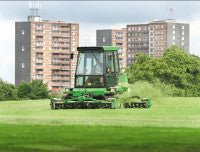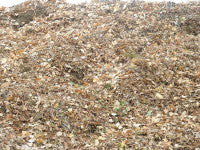Rubbish TIPS!
 Waste management is a hugely important topic on golf courses and parkland. The rate of waste generation is continuing to increase and existing waste disposal sites are reaching the end of their useful lifetime. It is no wonder that waste matters have become a matter of urgency
Waste management is a hugely important topic on golf courses and parkland. The rate of waste generation is continuing to increase and existing waste disposal sites are reaching the end of their useful lifetime. It is no wonder that waste matters have become a matter of urgency
Public awareness and expectation of a clean and green environment is high, be it on the streets or the golf club. Small, but significant changes in golf course management can reap great results in terms of waste prevention and reduction. Simple changes like on-site composting can benefit the environment greatly.
Source reduction, resource recovery, and waste disposal should be considered when planning an efficient solid waste management programme for the course. Some simple steps to improve the current waste management plans on a golf course can include the following:
• Dispose of chemicals in a responsible manner.
• Make a real effort to recycle.
• Buy recycled products.
• Leave clippings (grass and other organic materials) in place.
• Avoid over purchasing.
• Allow for naturalised areas to be created on the course (e.g. wildflower meadows, increase buffer zones).
• Onsite composting/mulching.
Grass clippings and other materials such as prunings and dead branches can be left in place to decompose where agronomically possible (taking account of aesthetics, playability, disease). Obviously, leaving grass clippings on greens is not an option, but areas that are not required to be as manicured can have clippings left where they fall.
This reduces the amount of waste being generated, allows nutrients to be returned to the ground and also reduces the amount of labour required to manage the course. If the clippings are going to be removed, then it is best to compost them or use them as mulching.
Disposing of any chemicals (herbicides, pesticides etc.) on the course in a responsible manner (and according to the label) is of mammoth importance. Extreme care must be taken to ensure chemicals do not enter waterbodies or leach into the soil.
Also, care needs to be taken so that chemicals are not left around the course for susceptible wildlife to come in contact with (birds can be particularly vulnerable). It is important to handle, store and dispose of hazardous wastes properly according to the label / laws. Storage areas for hazardous wastes should be secure and not accessible to susceptible wildlife species (or indeed the general public).
Containers should be in good condition to avoid leaks and, of course, labelled and dated clearly. Any batteries or used oil should be recycled or disposed of in a responsible manner. It is also important to make a real effort to recycle and also to buy recycled products (therefore driving the recycle market). Recycling office paper, score cards etc. is an easy step that can be taken along with ordering recycled products. It is important to ensure that the non-recyclable waste from the course is collected by a reputable collector.
Allowing for, or creating, naturalised areas or increasing the amount of areas left for nature and increasing bufferzones (no-spray zones) enhances the habitat value of golf courses and also decreases the inputs required for management, therefore minimising waste generated requiring management.
The nature of waste generation on golf courses lends itself to being very good composting material. Onsite composting and onsite mulching have numerous advantages for a golf course.
 Composting and mulching turns materials that would otherwise enter the waste stream into valuable resources for the course. Composting will reduce the quantity of waste being sent to landfill. Leaves, grass clippings and vegetation trimmings from the course are all suitable for composting.
Composting and mulching turns materials that would otherwise enter the waste stream into valuable resources for the course. Composting will reduce the quantity of waste being sent to landfill. Leaves, grass clippings and vegetation trimmings from the course are all suitable for composting.
Compost has the potential to act as a soil/sand improver. It is beneficial to micro-organisms, which improve soil structure and act as a slow release fertiliser on the course, although careful consideration must be made regarding issues such as organic matter accumulation and underlying soil type to avoid any layering issues.
Compost can be used on landscape plants on the course, as it improves the physical condition of soil which, in turn, improves aeration and water filtration and helps soils retain water and nutrients (particularly sandy soils). Composting, in principle, presents an ideal solution to the challenge of turning organic waste into a valuable resource aiding the natural cycle of nutrients.
Mulching of branches and wood, which are not being left in place for conservation reasons (i.e. safety, excess fallen wood) is ideal for mulching on site for use on the course. Mulch can be used around the course on landscaped areas to prevent weeds (reducing labour - manual removal, herbicide spot applications). Onsite mulching has many benefits including:
• Mulch conserves moisture
• Prevents weeds
• Adds organic matter to the soil
Litter on a course is unsightly to golfers, workers and by-passers. Bins should be provided on the course and, where possible, separate bins should be provided for recyclables. Signs reminding golfers to bring home litter can prove very successful. It also lets people know that waste is yet another element managed on the course. Positive image relating to the environment will encourage repeat visitors.
I would highly recommend that if one is serious about reducing and carefully managing waste, that golfers on the course and the local community are made aware of all efforts that are being made to protect the environment and manage the course in a sustainable manner. Golf course superintendents are, at the end of the day, in charge of vast tracks of valuable green space and it is vital that the community realise that the course is playing its part in protecting the local environment.
Waste Management should be high on the priority list for sustainable management of a golf course. Implementing a successful waste management plan involves making informed decisions for both the tactical (day to day) and strategic (long term) waste management operations specific to the course. The waste management plan on the golf course should be monitored, assessed and re-evaluated periodically to optimise the plan. Constant thinking and improvement of existing strategies will lead to a more rational and efficient waste management system for the golf course.
About the Author
Mary Purcell is currently carrying out research for a doctorate degree in Environmental Science at University College Dublin in the School of Architecture, Landscape and Civil Engineering. For more information contact Mary at mary.purcell@ucd.ie
